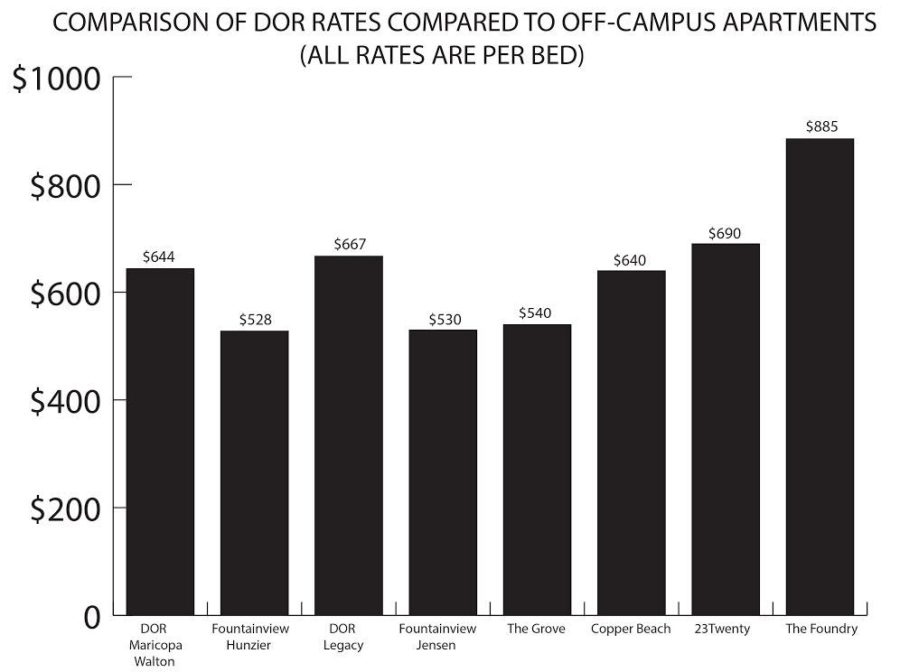Rising rent hits the residence halls
Jessica Kline/Iowa State Daily
Housing graphic
April 17, 2015
With increased enrollment and the Department of Residence’s plans for housing improvement, ISU students face rises in rent rates both on and off campus.
Pete Englin, director of the Department of Residence, said the cost of rent depends on a multitude of factors.
“Maintenance, utilities, labor to operate [and] staffing. We reinvest in our facilities as well,” Englin said.
Julie Hartl is the manager of building improvements and oversees all projects relating to university housing, from replacing furniture to complete renovations of buildings.
Hartl said Frederiksen Court buildings 41, 42 and 43 will receive new flooring and paint. The budget for this project is $870,000.
University Village will receive a $700,000 budget for window and roof replacements. University Village buildings 101-32, 143 and 145 will receive a $980,000 budget to replace patios.
“The budgets for our projects typically include all the expenses that we anticipate for a project, along with a contingency,” Hartl said.
A contingency is an amount kept in reserve to use in case an unexpected condition appears. Oftentimes, the contingency doesn’t need to be used, resulting in extra money at the end of the project.
“We try to identify needs and take care of them as necessary,” Hartl said.
Fredriksen Court is undergoing a “Life Cycle” project, where aspects of the apartments are fixed or improved every summer. This summer, the focus will be on flooring and paint.
“The apartment flooring will be changed from carpet to vinyl plank and the bathrooms will get sheet vinyl,” Hartl said.
These changes, along with new flooring in the common areas, will match the buildings that were renovated last summer.
Projects like the ones taking place this summer keep the apartments owned by the DOR up to date and competitive, Englin said.
Frederiksen Court and University Village are the only residence halls that will undergo major projects this summer, but the DOR continues to ensure renovations take place where they are needed.
The DOR examines maintenance requests, priority, available funds and time needed to complete the project in question when determining which residences need work.
“It is a very large puzzle to piece together,” Hartl said.
Rent will increase by 3 percent at Frederiksen Court, and 2 percent at the SUV apartments, Englin said.
Rent has never increased more than 4 percent during the past five years, which helps keep rates manageable for students.
“Generally, the rate increases pay for various projects, as well as annual operating cost increases,” Hartl said. “Operating costs” refers to utilities and paying the staff.
Englin said the DOR will mostly focus on updating housing this summer instead of complete renovations. Reinvesting in apartments is one of the methods to keep prices from rising too quickly.
“There’s no state revenue or tax dollars that come out way. It all comes out of student rental (fees),” Englin said.
“Every unit gets its turn,” Englin said. “This summer will focus on Freddy Court and SUV, while next summer another set of apartments will get renovated.”
Even though the rate of rent will increase, the Department of Residence has made sure the students agree with how the extra money will be used.
“We do ask that students in [the Inter-Residence Hall Association] and the Frederiksen Court Council actually vote, and let us know if they support the rate increase,” Englin said.
By providing a five-year plan, a financial statement and complete transparency, the DOR works with students to ensure the rate increase is the right thing to do.
“Our rate increases over the last five years have never been over 3.5 percent,” Englin said.
Rate proposals are taken to IRHA and a town hall meeting at the SUV Community Center to make sure students support where the extra money from the rent increase will go and how it will be used.
Paying rent each semester is an alternative option for students who don’t want to pay each month.
Because there is an increase in undergraduate students and demand for on-campus housing, semester billing provides an option that is “much [easier] for undergraduates, which in turn provides easier living.”
Unfortunately, this year won’t be the last that rent is expected to rise.
“Students should anticipate future rate increases, although not necessarily at the level assumed for planning purposes,” Hartl said.
Uncontrollable outside influences, such as competition from off-campus housing, also lead to a need for an increase in rates.
However, despite marginal increases across the board, the return rate for students has been 102 percent in junior and senior students, implying that some students move back on campus after living off-campus.
“Students seem to like what we’re doing,” Englin said. “We’re really excited about the next five years.”

















